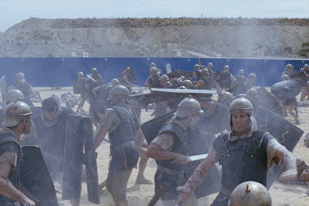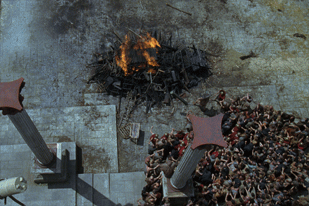Tara DiLullo returns to Rome to discover how the Emmy Award-winning vfx team had to cope with less time and money in delivering work with greater scale.

Back for season two of Rome is vfx supervisor James Madigan, who faced a whole new set of unexpected vfx and budgetary challenges, since matte paintings and environments couldn't be reused from last year. All images courtesy of HBO.
Caesar may be dead but the treachery, violence and debauchery behind the machinations of the Roman Empire are only getting started as the second season of the epic BBC/HBO drama, Rome, debuted on Jan. 21. The fall of the Republic continues to be chronicled in expansive scope and accuracy against the backdrop of the smaller, human stories of love, honor and betrayal that reflect the larger issues of the ancient society imploding upon itself. Back for the thrilling ride behind-the-scenes is visual effects supervisor James Madigan. Back for the thrilling ride behind-the-scenes is visual effects supervisor James Madigan, who returns to Rome after working with vfx house The Senate on The Da Vinci Code during the production hiatus.
After winning an Outstanding Visual Effects Emmy for the season debut, Madigan admits season two of Rome offered a whole new set of unexpected vfx and budgetary challenges for his team. "It seems like it would be easier having already done the first season," Madigan relates. "There was very much an attempt to reuse matte paintings and environments, but to be honest, there wasn't much reuse of things from last year. Most of the views we're looking at this season are new places or are places we saw last [time] -- 12 years later. Most of the things that are a direct repeat of places we saw are usually things I wanted to improve on anyway so they were reworked. The main thing that was nice about coming back a second time was that you already know everyone "

With the tightening of the budgetary belt, this season was more controlled and preplanned as opposed to last year, when the vfx team constantly filled in bits of backgrounds and the set had patches of bluescreen everywhere.
A hallmark of the series is the scale and attention to detail mandated by the producers, who had a huge budget for the initial season. While the first year was a critical success, Rome had to deal with severe cutbacks for its sophomore season. Madigan admits, "The budget this season was considerably tighter. I'd say we had less than half the amount of money and about 1/10th the amount of time to play with that we had last year. The shot count was lower but the shots themselves were much bigger in scale. Last season we were constantly filling in bits of backgrounds. The set had patches of bluescreen everywhere so whenever we shot the exterior sets there was another shot. This season it was much more controlled and preplanned Any approach that could save money and time was put in play. I had a still camera and a DV camera with me all the time and any trip I made, while in Italy, I wound up supplying us with resources for our matte paintings. We had small strips of blue that I would put up behind extras when the main unit would let me steal the B or C camera to get elements for the shots without extra costs. It was a bit 'by the seat of our pants.' Any opportunity to get a piece of something had to be capitalized on."
With the universal tightening of the budgetary belt, Madigan says the collective goal to streamline the production helped bring both his personal vfx goals and those of the producers in line. "The mentality of the producers and HBO this season as far as vfx were concerned was that when we do decide to spend money let's make it worthwhile, I'd say in that aspect we meshed. There was very much a concern to not shy away from the big battle sequence this time, which was cool. As far as 'vfx goals,' to be honest, when I considered the bit of history that we would be covering, I envisioned the vfx being much more epic than season one as far as the amount and size of our work, which would have been nice. But, as it is, we've been able to do a lot of great work and considering the amount of time we have to get it done, there is just no way more could have been handled. We've had some really incredible artists working very hard to get it through in the time we had."

Close attention was paid to recreating the Aventine, where a great deal of this season takes place. Madigan and his team researched the boat and river activity around where this place would have been.
Madigan and his team had a short break of six months between seasons and upon their return, he immediately set about building the new pipeline of vfx houses that would create his effects for the season. "As with last year, the majority of the work was done by The Senate Visual Effects [of Twickenham, England], which was a real life saver On season one, The Senate had about 30 compositors, four matte painters and six 3D artists. This season, The Senate had about six compositors one matte painter and four 3D artists who did about 85% of the work across all 10 episodes. They've pulled off some amazing things.
"Besides The Senate, I had two other facilities working on Rome, neither of which were involved last year. The Moving Picture Co. (MPC) did the really big battle shots. We had quite a few shots that show the entire scope of Philippi, all 200,000 men going at each other. MPC had done a lot of these kinds of shots on Troy and Kingdom of Heaven. These shots were all extremely difficult, but they did a fantastic job in a very limited time frame. Some of these shots had billions of polygons to render with one render taking over a week to get through, yet any changes that were needed were always addressed. It has been a very good experience with them.

A major vfx undertaking was the battle at Philippi, the largest battle of antiquity. During the battle, a whole scene takes place in front of bluescreen requiring a full 3D environment.
"Rainmaker UK did everything involving Egypt, which is pretty tricky. Basically when we do exterior Egypt on Rome they go out in the middle of the Forum set on the backlot, put down some sand and string up about 80 meters of bluescreen and that's Egypt. The harbor of Alexandria is a pretty iconic place with the famous lighthouse, which is one of the eight wonders of the world. It's a view that has a lot to live up to and considering it's all CG, all the water, all the boats, all the people -- it's a big job. Also, for some reason Egypt is always in the later episodes so we have the least amount of time to get it done. Rainmaker is doing all that plus the interiors of Cleopatra's palace and the desert exteriors as well. The work they're doing is beautiful. They're really up against it right now, but they've been turning shots around at a pretty incredible pace."
The attention to actual geography and recreating historic icons for the screen is a big part of Madigan's work, and this season provided new landscapes to research, especially the Aventine in Rome. "A great deal of this season takes place around the Aventine, which was where most of the boats coming up river from the sea would unload their cargo and trade with Rome. Where I lived in Rome was very close to the real Aventine, and there are still a great deal of ancient temples and ruins from 2,000 years ago there. When you see the wide shot of the Aventine that closes the first episode of season two, most of the things you see in this environment are actually from photographs I took of the real Aventine. The bend in the river around the Aventine fits exactly into the environment we were creating. Even the element of the river flowing was shot from this spot. The mountain you see in the distance in this shot is Frascati, which is actually the mountain you see when you look in this direction on the Aventine. We researched quite a bit what the activity around this place would have been and I tried to keep all this in mind as I shot people on bluescreen to go in the background."

Amputations were a combination of a mesh modeled in modo brought into Maya, made into soft bodies, animated and textured with sub-surface scattering, then rendered with mental ray. The CG blood is done in RealFlow.
Madigan said another major undertaking this season was the battle at Philippi. This was the largest battle of antiquity where Mark Antony and Octavian combined forces to take on Brutus and Cassius. "There were roughly about 200,000 men fighting at Philippi -- all Roman -- and there is a great deal written in the historical records about its confusion and brutality. It was by all accounts one of the most dramatic moments in Roman history and something that changed the course of history significantly. We research everything we could about Roman fighting techniques, the geography of Philippi in Greece and the positioning of the two armies. The story of just Philippi itself could merit an entire miniseries. As far as it was possible, we wanted to make sure what we did was historically correct and helped tell the story." The battle is featured in episode six and Madigan says it's clearly been the most difficult episode of the season for his crew. "Not only is there Philippi, but we also have some big shots of the Aventine and some other killings Also, a whole scene takes place in front of bluescreen requiring a full 3D environment with some shots several thousand frames in length."
On the technical side, Madigan explains that they shifted their modeling systems this year to handle their maturing needs. "We're using ZBrush and modo to model, whereas last year we modeled everything in Maya." With violence and amputations a big part of the first season depiction of the rawness of Roman society, season two follows the same path and Madigan again used CG to help depict that brutality onscreen. "The amputations are a combination of a mesh modeled in modo brought into Maya, and made into soft bodies and animated there and textured with sub-surface scattering, then rendered with mental ray. The CG blood is done in RealFlow, which I'll reserve comment on."
Currently in the waning days of the show's post-production, Madigan admits he is again proud of the work and admits he's learned two key things this year: "Probably how to seize every possible opportunity to get the most you can on a limited budget and where the best place to get seafood in Rome is."
Tara DiLullo is an East coast-based writer whose articles have appeared in publications such as SCI FI Magazine, SFX and Lost Magazine. She is the author of the books 300: The Art of the Film and 24: The Official Companion Guide: Seasons 1 & 2.







